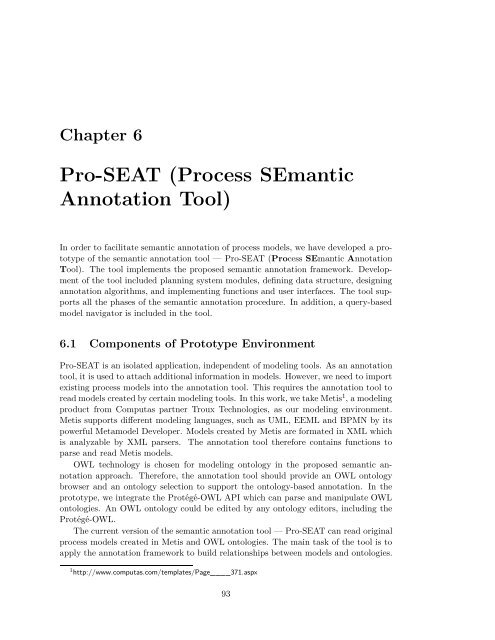Semantic Annotation for Process Models: - Department of Computer ...
Semantic Annotation for Process Models: - Department of Computer ...
Semantic Annotation for Process Models: - Department of Computer ...
You also want an ePaper? Increase the reach of your titles
YUMPU automatically turns print PDFs into web optimized ePapers that Google loves.
Chapter 6<br />
Pro-SEAT (<strong>Process</strong> SEmantic<br />
<strong>Annotation</strong> Tool)<br />
In order to facilitate semantic annotation <strong>of</strong> process models, we have developed a prototype<br />
<strong>of</strong> the semantic annotation tool — Pro-SEAT (<strong>Process</strong> SEmantic <strong>Annotation</strong><br />
Tool). The tool implements the proposed semantic annotation framework. Development<br />
<strong>of</strong> the tool included planning system modules, defining data structure, designing<br />
annotation algorithms, and implementing functions and user interfaces. The tool supports<br />
all the phases <strong>of</strong> the semantic annotation procedure. In addition, a query-based<br />
model navigator is included in the tool.<br />
6.1 Components <strong>of</strong> Prototype Environment<br />
Pro-SEAT is an isolated application, independent <strong>of</strong> modeling tools. As an annotation<br />
tool, it is used to attach additional in<strong>for</strong>mation in models. However, we need to import<br />
existing process models into the annotation tool. This requires the annotation tool to<br />
read models created by certain modeling tools. In this work, we take Metis 1 , a modeling<br />
product from Computas partner Troux Technologies, as our modeling environment.<br />
Metis supports different modeling languages, such as UML, EEML and BPMN by its<br />
powerful Metamodel Developer. <strong>Models</strong> created by Metis are <strong>for</strong>mated in XML which<br />
is analyzable by XML parsers. The annotation tool there<strong>for</strong>e contains functions to<br />
parse and read Metis models.<br />
OWL technology is chosen <strong>for</strong> modeling ontology in the proposed semantic annotation<br />
approach. There<strong>for</strong>e, the annotation tool should provide an OWL ontology<br />
browser and an ontology selection to support the ontology-based annotation. In the<br />
prototype, we integrate the Protégé-OWL API which can parse and manipulate OWL<br />
ontologies. An OWL ontology could be edited by any ontology editors, including the<br />
Protégé-OWL.<br />
The current version <strong>of</strong> the semantic annotation tool — Pro-SEAT can read original<br />
process models created in Metis and OWL ontologies. The main task <strong>of</strong> the tool is to<br />
apply the annotation framework to build relationships between models and ontologies.<br />
1 http://www.computas.com/templates/Page____371.aspx<br />
93
















